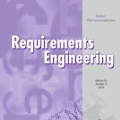The fundamental objective of this research work is to develop a Software Requirement Engineering Healthcare Implementation Maturity Model (SRE-HIMM) that will assist healthcare organizations to effectively evaluate and implement HIS development process. The model was developed based on the systematic literature review (SLR) approach and Empirical results. The 53 primary studies were extracted using the SLR approach and CSFs, CBs, and best practices were identified form the extracted primary studies. The identified success factors and barriers were further ranked using the analytical hierarchy process (AHP) approach. Furthermore, I have adopted the critical success factors (CSFs) and critical barriers (CBs) instead of PAs and available Maturity models i.e., CMMI for the development of (SRE-HIMM). The identified CSFs and CBs were classified into five maturity levels based on the CMMI, IMM, and SOVRM. The empirical investigation was conducted HIS experts to evaluate the findings of SLR. Further, a case study was conducted with the company to evaluate the effectiveness of SRE-HIMM which shows satisfactory results.
翻译:这项研究工作的基本目标是开发一个软件要求工程保健实施期限模型(SRE-HIMM),该模型将协助保健组织有效评价和实施他的发展进程,该模型是根据系统文献审查(SLR)方法和经验结果开发的,利用SLR方法和CSF、CBs和最佳实践提取了53项初级研究,确定了初步研究的形式,通过分析等级分析(AHP)方法进一步排列了查明的成功因素和障碍,此外,我还采用了关键的成功因素(CSFs)和关键障碍(CBS),而不是PAs和现有的成熟模型,即CMMIM促进发展(SRE-HIMM)的成熟模式,根据CMMI、IMM和SOVRM的成熟程度,将已确定的CSFs和CB分为5个成熟水平,进行了经验调查,以评估SLR的调查结果。此外,我与公司进行了一项案例研究,以评价SRE-HIMM的实效,显示令人满意的结果。





